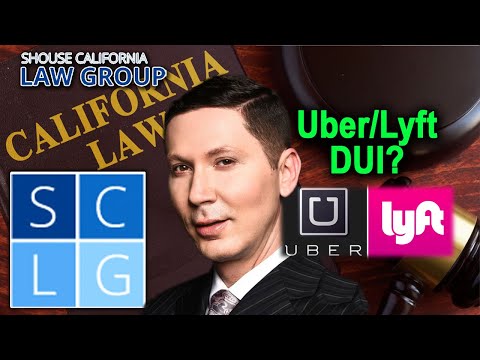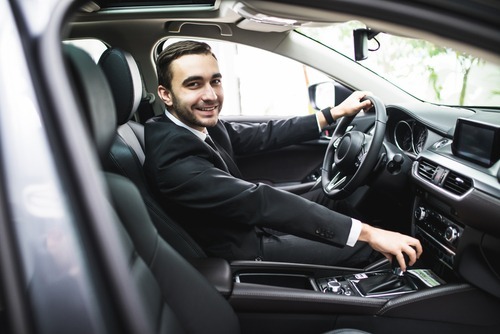
Vehicle Code § 23152(e) VC sets forth California’s DUI “per se” law for taxi, limo and ride-sharing drivers. These motorists are prohibited from driving with a blood alcohol concentration (BAC) of .04% or higher while a paying passenger is in the vehicle.
§ 23152(e) VC states that “Commencing July 1, 2018, it shall be unlawful for a person who has 0.04 percent or more, by weight, of alcohol in his or her blood to drive a motor vehicle when a passenger for hire is a passenger in the vehicle at the time of the offense. For purposes of this subdivision, “passenger for hire” means a passenger for whom consideration is contributed or expected as a condition of carriage in the vehicle, whether directly or indirectly flowing to the owner, operator, agent, or any other person having an interest in the vehicle.”
The law makes the “legal limit” for ride-sharing drivers the same as for commercial drivers in California.1 It contrasts with California’s legal limit of .08% BAC for most drivers age 21 and over.
The .04% legal limit for California ride-sharing drivers also applies under California Vehicle Code 23153(e) – DUI causing injury
When am I deemed to be under the influence as a ride-sharing driver?
A taxi, limo or ride-sharing driver is considered “under the influence” in California if:
- Your physical or mental abilities are impaired to the extent that you can no longer drive as well as a cautious sober person,2 or
- Your “blood alcohol content” (BAC) exceeds:
- .04% if paying passengers are in the vehicle, or
- .08% at other times.3
BAC levels are determined by a DUI breath test or DUI blood test given after a lawful arrest and within three (3) hours of driving.4
Penalties
The following chart summarizes the basic criminal penalties for a non-injury California DUI:5
| Type of California DUI | Imprisonment and/or Fine |
|---|---|
| 1st offense misdemeanor DUI | Up to 6 months
$390-1000 |
| 2nd offense misdemeanor DUI | 96 hrs.-1 year
$390-1000 |
| 3rd offense misdemeanor DUI | 120 days-1 year
$390-1000 |
| Felony DUI | 16 mos.-3 years $390-1000 |
| DUI with injury (misdemeanor) | 5 days-1 year
$390-5000* |
| DUI with injury (felony) | 16 mos.-16 years
$1015-5000* |
| *Plus possible criminal restitution to injured parties. |
DMV license suspension for ride-sharing DUI
In addition to (or instead of) court-imposed criminal penalties for DUI, the California DMV may impose:
- A license suspension or revocation (though in some cases a restricted California driver’s license may be available, or you may be able to continue driving with an ignition interlock device (IID) installed), and
- Mandatory DUI school.
These administrative penalties are indicated in the following chart:
| Type of California DUI | Term of Suspension / Revocation & DUI School |
| 1st offense misdemeanor DUI | 6 to 10 months, plus
3 or 9 months DUI school |
| 2nd offense misdemeanor DUI | 2 years suspension, plus
18 or 30 months DUI school |
| 3rd offense misdemeanor DUI | 3 years, plus
30 months DUI school |
| DUI with injury (misdemeanor) | 1 to 3 years, plus
3, 18 or 30 months DUI school |
| DUI with injury (felony) | 5 years, plus
18 or 30 months |
| Felony DUI | 4 years, plus
18 or 30 months |
Legal defenses
Legal defenses if you are a ride-sharing driver charged with California DUI can include (but are not limited to):
- You were not carrying a paying passenger;
- The police did not follow proper procedures when they stopped or arrested you;
- The police did not follow proper procedures in administering the DUI breath test or DUI blood test; or
- There were laboratory errors that made the DUI chemical test results unreliable.
To help you better understand DUI by Uber and Lyft drivers, our California DUI lawyers discuss, below:
- 1. Whom does 23152e VC apply to?
- 2. What is California’s “DUI per se” law for ride-sharing drivers?
- 3. What are the penalties?
- 4. What are the defenses?

1. Whom does 23152(e) VC apply to?
Vehicle Code 23153(e) VC applies to you if you have a “passenger for hire” in your vehicle at the time of the offense. A “passenger for hire” is someone who is expected to pay for the ride as a condition of being driven, including:
- Uber, Lyft and other ride-sharing passengers;
- Taxi passengers; and
- Passengers in limousines with fewer than 10 people in the vehicle (including the driver).6
The compensation need not be paid directly to you. A passenger is “for hire” if:
- Money is paid to a company (for instance, through the Uber or Lyft app), or
- Compensation is given directly to you in the form of cash, a credit card or otherwise.7
Note that “passenger for hire” does not include passengers in carpools or rides in which friends simply contribute gas money for the trip.
2. What is California’s “DUI per se” law for ride-sharing drivers?
23153(e) VC sets forth California’s “per se” DUI law for ride-sharing drivers. “Per se” is a Latin term meaning “of itself.”
If you meet or exceed the applicable California DUI per se “legal limit” of .04%, it does not matter whether your driving is actually impaired. You will be deemed under the influence even if you are actually driving fine.
Per the Centers for Disease Control and Prevention, the driving ability of many people is not significantly impaired at .04 BAC.8
California’s various DUI “per se” legal limits are indicated in the following chart:
| Type of Driver (CA Vehicle Code §) | CA Legal BAC Limit |
|---|---|
| Adult driver, non-commercial vehicle
(including off-duty Uber/Lyft drivers) (Vehicle Code 23152(b) VC) |
.08% |
| On-duty Uber or Lyft drivers
(Vehicle Code 23152(e) VC) |
04%
(as of July 1, 2018) |
| Taxi and limo drivers while in their taxi/limo
(Vehicle Code 23152(e) VC) |
04%
(as of July 1, 2018) |
| Driver of commercial vehicle (while in commercial vehicle)
(Vehicle Code 23152(d) VC) |
.04% |
| Driver under 21*
(Vehicle Code 23140 VC) |
.05% |
| *California also has a “zero-tolerance” law with a limit of .01% for underage drivers.
(Vehicle Code 23136 VC) |
2.1. Why did the legal limit for ride-sharing drivers change?
California DUI law used to treat ride-sharing drivers the same way as any other driver. California’s legal limit for adult drivers (21 and over) of non-commercial vehicles is .08%.9
Though “commercial drivers” are subject to a stricter .04% legal limit for alcohol in California. Lowering the legal limit for alcohol to .04% essentially makes taxi, limo and ride-sharing drivers into commercial drivers when a paying passenger is in the vehicle.
According to the California District Attorneys Association, which sponsored the change in the law:
“Taxi drivers and drivers for hire… present an increased risk to public safety when driving under the influence of alcohol or drugs while carrying passengers for hire… This behavior also violates their passengers’ trust that they will be able to get their passengers safely from point A to point B, despite the frequency with which we encourage the use of these alternatives to drinking and driving.”10
2.2. Does having a BAC of less than .04% prove I was not impaired?
No. Having a BAC of less than .04% is not proof that you were not impaired.
California’s DUI laws prohibit driving if you are not able to drive safely due to any amount of alcohol and/or drugs in your system).11
3. What are the penalties?
DUI penalties for Uber/Lyft/ride-sharing drivers under Vehicle Code 23152(e) are the same as for “regular” DUI. A first DUI offense is a California misdemeanor that can be punished by:
- Up to 6 months in county jail, and/or
- A fine of $390-$1000.
You may also face an administrative DUI license suspension hearing at the California DMV.
For a further discussion of the possible consequences of a DUI, please see our article “California DUI Penalties, Punishments and Sentencing.”
3.1. Will I lose the right to drive for Uber or Lyft?
By law, taxi, limo and ride-sharing companies may not employ you if you have been convicted of a DUI within the prior seven (7) years.12
This makes fighting a DUI especially important if you drive passengers for a living.
4. What are the defenses?
Legal defenses to Vehicle Code 23153(e) charges fall into three primary categories:
- You did not have a passenger for hire in the vehicle;
- The traffic stop or arrest was unlawful; and/or
- Procedures for administering the DUI breath test or DUI blood test did not comply with Title 17 of the California Code of Regulations.
For an in-depth discussion on these and other defenses, please see our article on “20 Ways to Beat a California DUI.”
4.1. “Dry reckless” as a plea bargain to DUI charges
One way you might avoid the consequences of a DUI conviction is with a California “dry reckless” plea bargain. A “dry reckless” is when:
“a person who drives a vehicle upon a highway in willful or wanton disregard for the safety of persons or property is guilty of reckless driving.”13
Although a conviction for dry reckless driving can result in jail time, it does not involve an admission of alcohol and/or drug use. Advantages of a dry reckless plea include:
- A shorter possible jail sentence,
- A shorter probation period,
- Lower total fines,
- No mandatory driver’s license suspension,
- Will not disqualify you from working as a taxi, limo or ride-sharing driver, and
- Will not increase penalties if you are arrested for DUI again in the future.
For additional help…

Contact us for additional help.
If you were accused of a DUI with a paying passenger in the vehicle, we invite you to contact our California DUI defense lawyers for a consultation.
Call us or complete the form on this page to discuss your case in confidence with a lawyer.
Also see our page on Can you drive for Uber with a DUI?
Legal references:
- California Vehicle Code 23152(d) VC.
- Vehicle Code 23152(a) [due to alcohol], (f) [due to drugs] or (g) [due to a combination of alcohol and drugs].
- Vehicle Code 23152(e) [when paying passenger is in the vehicle] or (b) [California’s “regular” adult DUI per se law].
- Vehicle Code 23152(e).
- The penalties listed here are set forth in California’s main DUI penalty laws: Vehicle Code sections 23536, 23540, 23646, and 23566.
- Vehicle Code 23152(e). See also Vehicle Code 15278 VC – Vehicles for which a commercial driver’s license is required.
- Same.
- Centers for Disease Control and Prevention, Impaired Driving: Get the Facts; See also Medicine.net Alcohol Impairment Chart.
- Vehicle Code 23152(b).
- See Bill Analysis of AB 2687 by California Senate Committee on Public Safety, June 28, 2016.
- Vehicle Code 23152(a).
- California Public Utilities Code 5445.2 (a)(3).
- California Vehicle Code 23103 VC.
